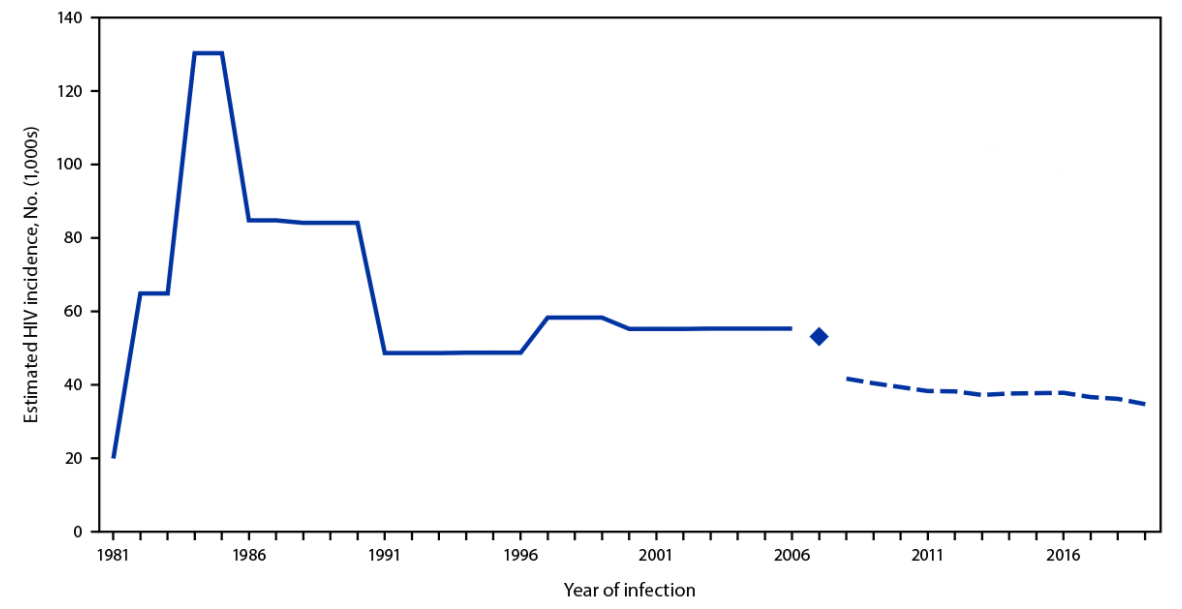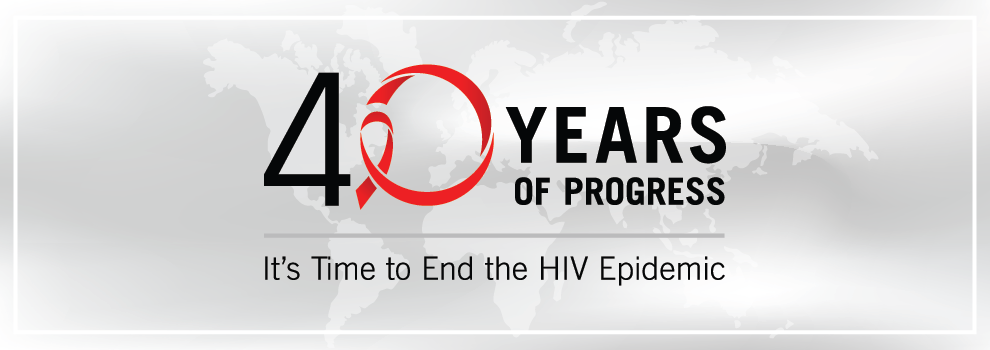Inside This Issue: Trends in U.S. HIV incidence, HRSA data report on COVID-19 and HIV services, key questions about COVID-19 and HIV, perspectives on the 40th anniversary of HIV/AIDS, and more.

U.S. HIV Epidemic
CDC Reviews Progress in Reducing HIV Incidence & Urges Action to Address Health Inequities
The estimated incidence of HIV infection in the U.S. has decreased 73% from its peak of about 130,400 during 1984 and 1985 to a low of 34,800 in 2019, according to a CDC report released earlier this month. HIV incidence was relatively stable during the period from 1991 through 2007, with approximately 50,000 to 58,000 infections annually, and has gradually decreased in the years since. Throughout the course of the epidemic, the majority of infections has been attributable to male-to-male sexual contact (63% in 1981 and 66% in 2019). However, over time, the proportion of HIV infections has increased among Black/African American persons (from 29% in 1981 to 41% in 2019) and among Hispanic/Latino persons (from 16% in 1981 to 29% in 2019).
“Despite the lack of a cure or a vaccine, today’s HIV prevention tools, including HIV testing, prompt and sustained treatment, preexposure prophylaxis, and comprehensive syringe service programs, provide an opportunity to substantially decrease new HIV infections,” the report authors noted. “Intensifying efforts to implement these strategies equitably could accelerate declines in HIV transmission, morbidity, and mortality and reduce disparities.”
In a Dear Colleague letter accompanying the report, CDC Director Dr. Rochelle Walensky wrote, “. . . longstanding, systemic health and social inequities – including discrimination, homophobia, transphobia, stigma, poverty, systemic racism, homelessness, and unequal access to quality healthcare – prevent access to testing, treatment, and other prevention services and further drive inequities. We can and must to better.”
“Only by addressing the root causes of these inequities and pursuing innovative solutions designed to reach people where they are with effective treatment and prevention strategies can we end this epidemic,” according to Dr. Walensky. “This means expanding self-testing, increasing the number of mobile options for service delivery, and employing creative community outreach and engagement strategies for groups disproportionately affected by HIV. Prevention and care efforts must expand beyond traditional healthcare settings in ways that respond to community needs.”
HIV and COVID-19
HRSA Report Focuses on COVID-19 Services Provided to RWHAP Clients
The 2020 Coronavirus Aid, Relief, and Economic Security Act (CARES Act) appropriated $90 million to the Ryan White HIV/AIDS Program (RWHAP) to prevent, prepare for, and respond to the COVID-19 pandemic. This funding supported existing RWHAP Parts A, B, C, and D recipients for the prevention and treatment of COVID-19 for RWHAP-eligible clients and their immediate household members. RWHAP recipients have been required to monitor and report on their CARES Act-funded activities, including the number of people served and the types of services provided for the treatment or prevention of COVID-19.
The Health Resources and Services Administration (HRSA) recently published a Ryan White HIV/AIDS Program COVID-19 Data Report that summarizes activities from January 20 through December 31, 2020. For your convenience, we have summarized selected highlights from the report below:
Telehealth: During the initial reporting period (January 20-March 31, 2020), 357 RWHAP service providers reported having any telehealth capacity for at least one core medical or support service. However, during the remaining months of the year, that number nearly doubled to between 655 and 703 service providers.
COVID-19 Testing: The proportion of RWHAP service providers who conducted COVID-19 testing rose rapidly from 29.2% in the initial reporting period to 40.0% in April, and then increased slowly thereafter, reaching 48.9% in December. By the end of the year, RWHAP service providers had conducted a total of more than 87,000 COVID-19 tests for RWHAP-eligible clients and immediate household members.
COVID-19 Cases Among RWHAP-Eligible Clients: During 2020, RWHAP CARES Act–funded service providers reported serving a total 18,798 RWHAP-eligible clients who had newly identified COVID-19.
Persons Receiving CARES Act-Funded Services: Between June and December 2020, the number of RWHAP-eligible clients and immediate household members who received at least one core medical or support service using RWHAP CARES Act funding ranged from 72,475 to 92,114 per month. The services most commonly received in 2020 were outpatient/ambulatory health services (38.5% of clients); medical case management (22.6%); and food bank/home-delivered meals (15.3%).
KFF Issue Brief Examines Key Questions About HIV and COVID-19
The Kaiser Family Foundation (KFF) recently published an issue brief that considers several key questions about HIV and COVID-19 and summarizes the current state of knowledge on the interplay of these two conditions and efforts to address their impacts. These questions include:
- Are people with HIV at higher risk for COVID-19?
- How do the social determinants of health, and their relationship to HIV, affect COVID-19 risk? (The social determinants examined include race/ethnicity, age, sexual orientation, and income.)
- How likely is it that people with HIV live in COVID-19 hot spots?
- What do we know about COVID-19 vaccines and HIV?
- What role is the federal government playing in addressing COVID-19 among people with HIV?
- What do we know about HIV care, treatment, and prevention service use during the pandemic? (Please note that the KFF issue brief was published before the release of the RWHAP COVID-19 data report summarized earlier in this issue.)
%20small.jpg)
Global HIV Epidemic
New Global Pledge to Reduce HIV Infections and Deaths and End HIV Inequalities
At the recently concluded United Nations General Assembly High-Level Meeting on AIDS, U.N. member states adopted the Political Declaration on HIV and AIDS: Ending Inequalities and Getting on Track to End AIDS by 2030. The declaration sets ambitious targets for reducing new HIV infections and deaths and has the goal of ending all inequalities faced by communities and people affected by HIV.
The political declaration calls on countries to provide 95% of all people at risk of acquiring HIV within all epidemiologically relevant groups, age groups, and geographic settings with access to people-centered and effective HIV combination prevention options. It also calls on countries to ensure that 95% of people living with HIV know their HIV status, 95% of people who know their status to be on HIV treatment, and 95% of people on HIV treatment to be virally suppressed. If the international community reaches the targets, a total of 3.6 million new HIV-infections and 1.7 million AIDS-related deaths will be prevented by 2030, according to UNAIDS.
The declaration notes that key populations – gay men and other men who have sex with men, sex workers, people who inject drugs, transgender people, and people in prisons and closed settings – are more likely to be exposed to HIV and face violence, stigma, discrimination and laws that restrict their movement or access to services. To address these inequities, U.N. member states agreed to a target of ensuring that, by 2025, less than 10% of countries have restrictive legal and policy frameworks that lead to the denial or limitation of access to services. They also committed to ensuring that less than 10% of people living with, at risk of, or affected by HIV face stigma and discrimination by 2025.
The U.N. member states also committed to increase and fully fund the AIDS response. They agreed to invest $29 billion annually by 2025 in low- and middle-income countries. This includes investing at least $3.1 billion in societal measures including the protection of human rights, reduction of stigma and discrimination, and law reform.
%20small.jpeg)
HIV Treatment
HHS Releases Update to the HIV Treatment Guidelines
On June 3, the U.S. Department of Health and Human Services (HHS) released the latest update to its Guidelines for the Use of Antiretroviral Agents in Adults and Adolescents with HIV. The update includes new guidance and information regarding:
- drug regimens to use when starting antiretroviral therapy (ART);
- treatment options for patients with virologic failure on their current ART regimen;
- management of patients with poor CD4 count recovery and persistent inflammation despite suppressive ART;
- optimizing ART in the setting of viral suppression;
- management of particular patient populations, including adolescents and young adults, women, people with substance use disorder; and people with tuberculosis/HIV coinfection;
- cost considerations and ART; and
- drug-drug interactions between antiretroviral drugs and other medications.

Milestones and Commemorations
Perspectives on the 40th Anniversary of HIV/AIDS
In the last issue of In Brief, we described some of the planned activities and resources developed to commemorate the 40th anniversary of the first reported cases of the illness that later became known as AIDS. A variety of additional materials have since become available, including several blog items published on the federal HIV.gov site offering different perspectives on the anniversary. For each post, we list the author and their associated agency or organization:
- Statement by President Joe Biden Recognizing the 40th Year of the HIV/AIDS Epidemic (The White House)
- After 40 Years of Progress, It’s Time to End the HIV Epidemic (Xavier Becerra, HHS)
- On the 40th Anniversary of the First Reported Cases of AIDS (Antony Blinken, U.S. Department of State)
- Reflection on 40 Years of HIV/AIDS Research (Dr. Maureen Goodenow, National Institutes of Health, Office of AIDS Research)
- 40 Years of Progress – OIDP Updates (Harold Phillips, HHS Office of Infectious Disease and HIV/AIDS Policy)
- Ending the HIV Initiative Reflects on 40 Years of HIV/AIDS (Elizabeth Maguire, U.S. Department of Veterans affairs)
- SAMHSA Commemorates the 40th Anniversary of the AIDS Epidemic (Kristin Roha, Substance Abuse and Mental Health Services Administration)
- I Am a Long-term Survivor of HIV (Antigone Dempsey, Health Resources and Services Administration, HIV/AIDS Bureau)
- Supporting Long-Term Survivors of HIV (Jeff Taylor, HIV+Aging Research Project-Palm Springs)

Educational Resources
HIV.gov Launches New Chatbot Tool
HHS recently launched the prototype of a new chatbot tool that is accessible from its HIV.gov site at bot.HIV.gov. The chatbot is “a conversational artificial intelligence tool designed to field questions about HIV with easy-to-understand answers from HIV.gov, CDC, and HHS-approved sources all built into a simple, accessible chat window,” according to HIV.gov. All interactions with the chatbot are completely private and anonymous.
This new platform allows users to search for HIV-related information by asking questions and engaging in a conversation with the chatbot. The tool was designed to expand the reach and impact of HIV.gov by making HIV information easier to access, navigate, and understand. The chatbot prototype has been programmed to answer over 80 unique questions that span the HIV continuum of care, as well as to provide guidance on the Ending the HIV Epidemic in the U.S. and related initiatives, such as Ready, Set, PrEP.
TPAN Publishes 2021 HIV Drug Guide
TPAN recently published its annual HIV Drug Guide for 2021. The guide includes a summary table that is an A-to-Z listing of approved HIV drugs with information on each individual drug or combination’s brand name, generic name, and drug category. For each medication and combination listed, the guide’s main section provides detailed information about the standard dosing, potential side effects and toxicity, potential drug interactions, drug manufacturer, wholesale price, and additional relevant information. The drug listings also include different perspectives on each drug and combination through physician and activist comments.

Other COVID-19 News
Recent Research Reports
CDC’s Morbidity and Mortality Weekly Report (MMWR) is providing continuing coverage of COVID-19-related research. CDC is archiving the MMWR reports on a page devoted to studies about COVID-19. For your convenience, we have compiled links to recent MMWR papers below:




.png)